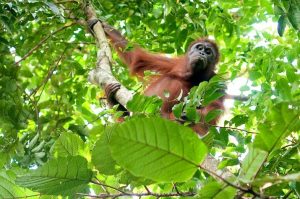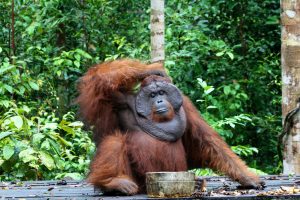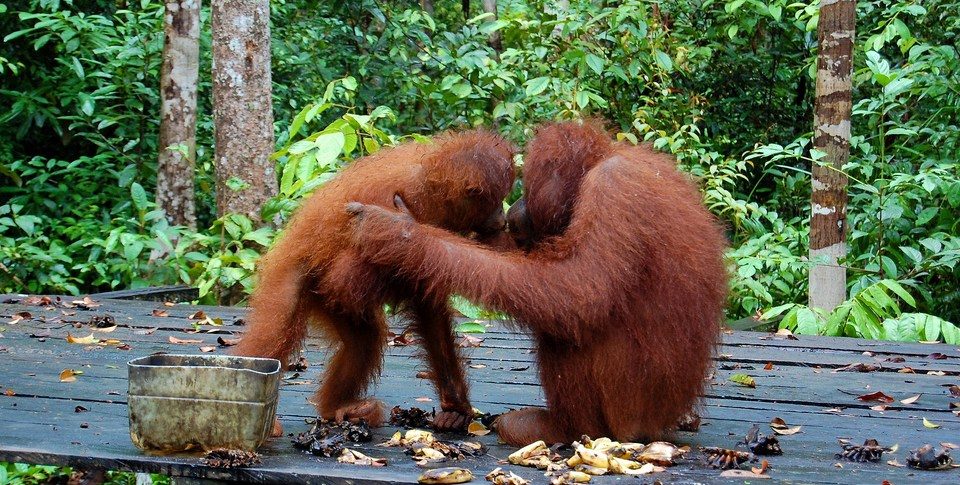By Catriona Croft-Cusworth for Forest News
The mainstream media is filled with stories about the plight of Indonesia’s increasingly endangered orangutans, who are threatened with poaching and the rapid destruction of their natural habitats due to deforestation.
In the wetlands of Indonesian Borneo, local people also tell many stories about the orang hutan – literally, the “forest people” – whose environment they share. In many such tales, the great apes are not victims but allies, helping humans by teaching them the secrets of the forest, or aiding them against their shared enemies.
The mythic power of these stories starkly affects perceptions about orangutans in a way that no environmental regulation or poaching law ever could. Take, for example, this story collected by researchers doing a case study on how folktales affect local people’s perceptions of the animal:
A Malay man said that, once, while logging in a protected area, he witnessed a colleague shoot an orangutan from a tree.
As the animal fell, they saw that it was a female orangutan holding her young. Before she died, the man said, the mother orangutan took a big leaf and expelled her breast milk onto it for her baby to feed on.
“He was really sad when he witnessed that the mother was so close to her baby. He cried when he told the story,” researcher Linda Yuliani said.
The story is retold with a surreal moral ending – the colleague who shot the orangutan had a pregnant wife at home, and when she gave birth the child was said to be covered in hair, just like an orangutan.

Protections and taboos
That anecdote resulted from a case study conducted within and around the Danau Sentarum wetlands of West Kalimantan, which found that traditions and stories among local people are playing a role in the conservation of orangutans and the forests they depend on.
The study shows that orangutan numbers remain highest in areas not only with good habitat condition, but also where informal institutions are strongest.
“There is a strong relationship between traditional knowledge systems and ecosystem condition,” says Yuliani, lead researcher on the study. “And this has implications for the conservation of wildlife.”
In some areas, informal institutions, such as customary rules, may have greater impact than formal legislation. Yuliani says that while very few respondents in the case study could identify laws or sanctions relating to orangutan conservation, the majority knew of and respected traditional beliefs and taboos.
As the Indonesian government moves to hand more rights over customary forests back to indigenous communities, findings like these will be essential for designing effective policies that incorporate traditional knowledge and promote collaboration between informal and formal institutions.
Blame Game
In the mainstream narrative, local people are often blamed for hunting, poaching and killing orangutans, as well as competing against them for resources in protected forest areas.
Over the past decade, the Bornean orangutan has gone from ‘Endangered’ to ‘Critically Endangered’ on the IUCN Red List of Threatened Species. In the Danau Sentarum National Park and its surrounds, a 2010 review found the number of orangutan nests in the area had dropped by 55% in less than a decade, from 264 nests in 2001 to only 147 in 2010.
Orangutans are protected by law in Indonesia, but their habitat in many cases is not. Land-use planning laws that favor large-scale development projects have led to widespread deforestation and land conversion for mining, timber and oil palm plantations.
Fire, illegal logging, and the effects of climate change have further destroyed the available habitat for orangutans, while poaching, hunting and illegal trade continues under weak law enforcement.
But the research by Yuliani and her team shows that orangutans remain better protected in areas where traditional beliefs and taboos are practiced, highlighting local people as allies in conservation efforts. The findings make the case for better collaboration, understanding and respect among formal and informal institutions.
Stories Old and New
Informal institutions surrounding orangutans in West Kalimantan include a range of beliefs, taboos and stories, from ancient traditions to more recent anecdotes.
Among Dayak sub-ethnic groups, ancestral traditions promote the belief that humans learned from orangutans how to assist in the delivery of babies, and how to use medicinal plants to sooth mothers after giving birth.
Others say that orangutans are reincarnations of respected members of the community, and therefore allow them to feed in their fruit gardens undisturbed.

There are stories old and new of orangutans serving as protectors of humans. Iban Dayaks are told by their grandparents and great-grandparents of the assistance given by orangutans during ethnic conflict in the 1900s.
More recent stories from the 1980s tell of an orangutan who protected a boy from a crocodile attack, and another who rescued a woman from a clouded leopard.
Such stories generate a sense of respect for orangutans, encouraging kind treatment and protection.
“These kinds of stories contain the dos and don’ts that people hear about since childhood, so their messages are strongly obeyed,” Yuliani says.
Call to Action
Traditions and anecdotes like these are powerful because they encourage or discourage certain types of behavior. They tend to encourage intrinsic motives for action, as opposed to the extrinsic enforcement of laws that may not align with local values.
So how can informal institutions be incorporated into formal conservation efforts and legislation?
Experience shows that a lack of collaboration with local people and their institutions is a common reason for conservation programs to fail. Local people should be seen as partners in conservation, the research suggests, with greater recognition of their knowledge, interests and rights in natural resource management.
“When there is collaboration between institutions, they should respect one another, and reinforce one another,” Yuliani says. “But the process takes time, energy, and a balance of interests.”
Further to this, Yuliani says that conservation efforts should not focus on a single species, but on the links between biological and cultural capital – such as orangutans and the stories that promote their protection.
“Degraded ecosystems cause degraded traditions, especially in cases where traditions are related to nature,” she says.
“By raising up traditions, ecosystems also benefit.”
A version of this article was originally published on Forest News, the Center for International Forestry Research (CIFOR) news site.
For more information on this topic, please contact Linda Yuliani at l.yuliani@cgiar.org. This research forms part of the CGIAR Research Program on Forests, Trees and Agroforestry.
This research was supported by the Great Ape Conservation Fund of the US Fish and Wildlife Service



